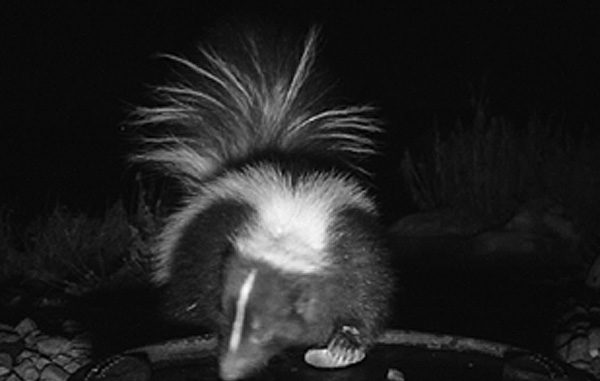
Bio Bites
By R. Gary Raham
A biologist-artist’s ruminations about our roles in a science-inspired world
Social media can be intimidating for many of us in the white-haired set, but I was reminded recently that online platforms like Facebook and Twitter command a virtual army of potential citizen scientists armed with tools that were once only available to a handful of professionals. Nancy Averett reported in the November 2019 issue of Discover magazine that an amateur Colorado photographer named Sue Dickerson recently discovered a previously unknown example of tool use by an animal: a skunk was caught in the act of using a stone to poke a hole in the ice covering the surface of water in a dish to get a late night drink. Dickerson, a Colorado Springs resident, posted her photos on Twitter. A scientist ran across the post, and nine months later Dickerson became a co-author of a scientific paper that appeared in the journal Ecosphere.
Averett quoted an animal behaviorist named Christian Rutz who said, “We’re starting to see some of the first examples of people doing this, but I think there is much more to come.” Rutz has an interesting example of an Hawaiian crow using a tool quite effectively on YouTube: https://www.bing.com/videos/search?q=crows+and+tool+use&view=detail&mid=7E499373B839733E76FD7E499373B839733E76FD&FORM=VIRE
Being at the right place at the right time—or having a motion-activated camera that you check regularly like Dickerson—can result in important scientific discoveries.
Fancy equipment is not a prerequisite for citizen science. My wife and I have volunteered in years past with the City of Fort Collins Master Naturalist program. We learned to recognize different frog calls in the Magpie Meander Natural Area to note which native species were there (like Chorus frogs) and which non-native species (like bullfrogs) might be invading the area. While that study is over, Fort Collins is enlisting citizen scientists to make bird and butterfly observations for their “nature in the city” project. (See https://www.fcgov.com/natureinthecity/)
Other opportunities abound at the national level. A program called Nature’s Notebook enlists citizens to track changes in the seasonal appearances of various plants and animals. This provides valuable information about animal and plant distribution during a time of shifting climate. (See https://www.usanpn.org/natures_notebook)
Also check out a citizen science home page at https://www.citizenscience.org/. The U.S. government also provides links to various projects nationwide that need citizen input: https://www.citizenscience.gov/#
Rutz (the crow scientist mentioned above) was also doing research on tool use by nuthatches. He decided to perform a classic Google search for “nuthatch tool use” and turned up a page at gardenbirdwatching.com that had video of nuthatches caught in the act of using a piece of wood to pry up willow bark in search of tasty grubs.
Human beings were once thought to be the only tool-users. That particular conceit died decades ago as a result of Jane Goodall’s work with chimpanzees, and all the work that has been done with corvids and other rather smart “bird brains” since then. Now even skunks have joined the tool-using club. But at least we humans have our social media tools—and it looks like we can do some good science while using them.
Support Northern Colorado Journalism
Show your support for North Forty News by helping us produce more content. It's a kind and simple gesture that will help us continue to bring more content to you.
BONUS - Donors get a link in their receipt to sign up for our once-per-week instant text messaging alert. Get your e-copy of North Forty News the moment it is released!
Click to Donate
